Located southwest of the famous Acropolis of Athens, the Philopappos Hill and the Pnyx are among the many ancient sites in the historic city. Both hills are historically significant in their own right, and are also great places for a walk and hike in the evening sun.
Location
The Philopappos Hill (Λόφος Φιλοπάππου) and the Pnyx (“Πνύξ” in Ancient Greek and “Πνύκα” in Modern Greek) are located on the western end of Dionysiou Areopagitou street (Οδός Διονυσίου Αρεοπαγίτου). Access is as simple as walking straight down the street, past the turn off to the Areopagus, and crossing Rovertou Galli street (Οδός Ροβέρτου Γκάλι). Be careful when crossing Rovertou Galli street, as both public buses and tour buses frequently stop at that particular stretch.
You’ll know you are where you need to be when you start seeing the tree-lined flagstone paved pathway, and brown signs denoting the “Hills of Muses” and the “Pnyx”. This is the main pathway running between Philopappos Hill and the Pnyx, and the trails to both hills branch off at either side further down.


The spot where the main pathway meets Rovertou Galli street is also a great place to photograph the Acropolis and Parthenon, but do note that tour buses are likely to block your shot.
The landscaping works of Dimitris Pikionis
The modernist landscaping of the area is the result of a carefully designed effort by architect Dimitrios Pikionis (Δημήτριος Πικιώνης) in the 1950s. The pathway, for instance, is composed of roughly (manually!) hewn asymmetrically yet geometrically shaped marble blocks salvaged from demolished local buildings. Strict care was also taken to plant flora indigenous to the Attica region.
The resulting work has been highly praised by many, and endures to this day as an “…almost timeless reading of the landscape of the area“. For myself, what struck me was the way in which the many elements of the landscape work blended together in a way that seemed natural – at home not only on the hill, but also when juxtaposed against the ruins of the Acropolis in the background. I couldn’t help but compare it to various other landscaped parks where the many elements seemed to impose themselves onto the existing landscape.
Further reading:
- “Dimitris Pikionis: The Man Who Shaped the Acropolis Landscape” – Dimitris Rigopoulos, Greece IS.
- Ellines.com’s profile of Dimitris Pikionis.
- The Architectural Review’s profile of Dimitris Pikionis.
The Church of Agios Dimitrious Loumbardiaris | Ναός Αγίου Δημητρίου Λουμραρδιάρη
Following the main pathway brings visitors to the main junction where the branches to the Philopappos Hill and the Pnyx diverge, but a sight not to be missed is the unassuming Church of Agios Dimitrious Loumbardiaris (Ναός Αγίου Δημητρίου Λουμραρδιάρη) located precisely at that location.

The tiny church, of the single-aisle vaulted type, is estimated to date back to the 9th century. It is named “Saint Demetrius the Bombardier” after an incident on 25 October 1658 that, according to tradition, saw an Ottoman official in Athens plot to destroy the church by cannon fire from the Acropolis only to be killed instead when thunder struck the gunpowder storehouse and killed him and his family.
The church was restored during Pikionis’s landscaping works in the 1950s, which revealed what are apparently some very nice frescoes from the post-Byzantine era. Unfortunately the church wasn’t open when I visited in the evening, so I wasn’t able to fully appreciate the church in full.
Moving to the back of the church reveals the pavilion / rest area that was designed and built as part of Pikionis’s landscaping works. While built to be a café and rest stop for visitors, the space today is currently café-less but still remains a nice quiet place to rest.
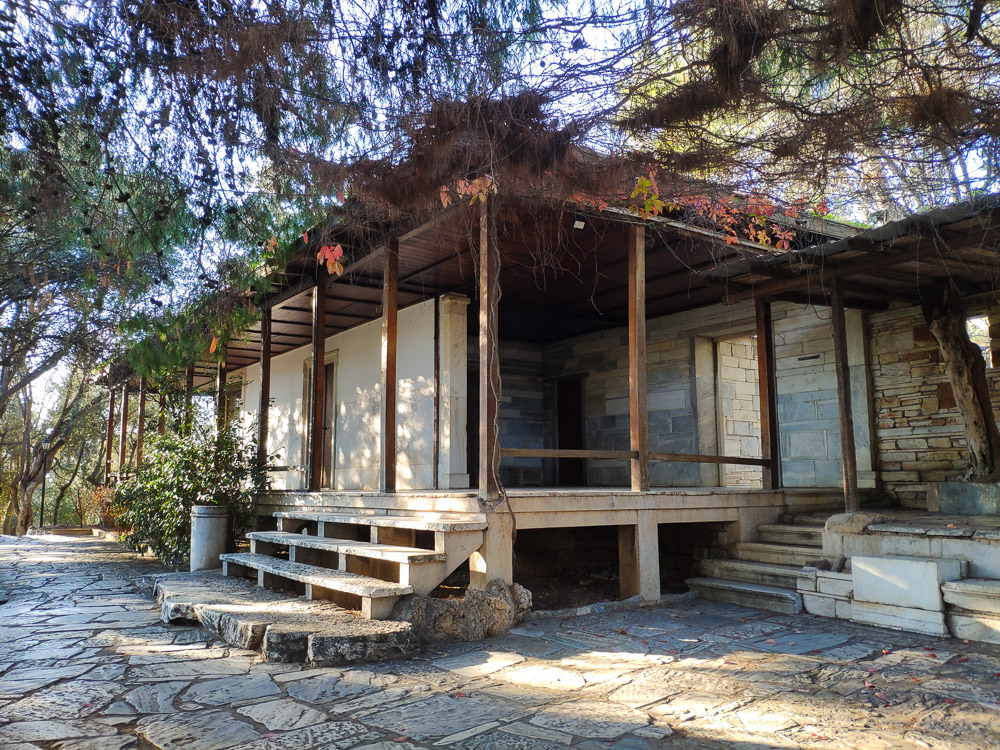
Socrates’ Prison
Just down the trail from the church is an impressive series of rooms carved into the rock. Traditional belief goes that this was the prison where Socrates was held awaiting execution after his trial in 399 BC for charges of, amongst others, corrupting the youth of Athens.

Not much remains at the site beyond carved openings for the interior space and the beam holes visible on the rocky surface. You can peer into the interior through the bars of the locked metal gates, but that’s about it.
It is now theorised that Socrates may have been held at the Athens State Prison by the Agora instead, which does make quite a bit of sense.
Philopappos Hill | Λόφος Φιλοπάππου
The Philopappos Hill, also known as the Hill of Muses, is 147 metres high. The Hill is dominated at the peak by the remains of the approximately 12 metres tall Philopappos Monument, built as a mauseoleum for Prince Gaius Julius Antiochus Epiphanes Philopappos of the Kingdom of Commagene after his death in 116 AD.
The Hill is a great place to spend the morning or the evenings, and many locals do certainly spend time taking a walk up the Hill. The paved trail up is on a gentle incline and is quite doable for newbies.
Walking up Philopappos Hill
The trail leading up Philopappos Hill is just across from the Church, and is well indicated by signage. The entire trail is paved, and was part of Pikionis’s landscaping works. In fact, the fully paved trail is a good way to examine the roughly hewn marble blocks characteristic of the project.


The trail takes visitors further up the hill and past what may look like marble ruins resembling benches – these are part of the landscaping and are indeed benches.


A spot not to miss is a viewing podium after the initial incline. This gives great views of the Acropolis with the Propylaia and Parthenon being particularly prominent. If photographing the Acropolis is what you’re after, this is one of the spots to set up your camera.


The podium also features more of the marble ruins repurposed as seating benches, and is a great place to rest your legs with a great view.
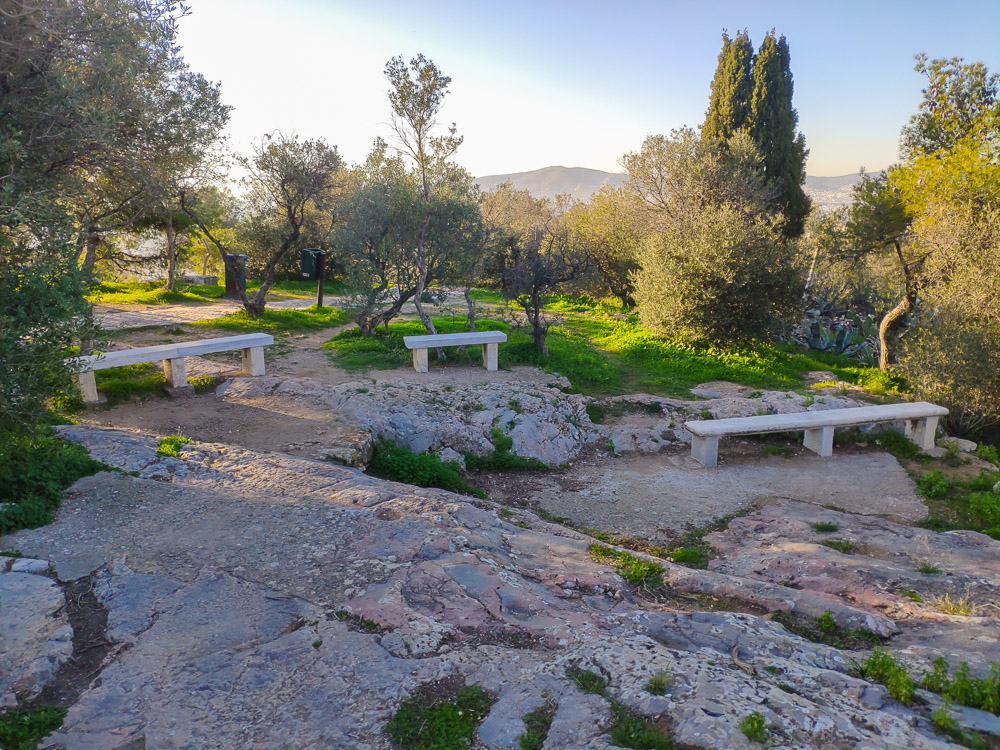

The trail then continues alongside remnants of the Diateichisma (Διατείχισμα), which formed part of the wall network that defended ancient Athens against attacks. You can even see the remnants of its circular towers.


The peak of Philopappos Hill
Move along further up and you’ll then reach the peak of the hill. This is where you’ll find the imposing Philopappos Monument.




The peak is also where you get great views of the modern city of Athens below, particularly of the eastern areas with Mount Hymettus (Υμηττός) looming over that part of the city. There is also a rocky spot right at the foot of the northeastern face Monument that gives you great views of both the Acropolis and the distinctive Lycabettus Hill behind it. This is obviously an uneven surface, so exercise extreme care.


A trail leads further away from the Monument to a rocky cliff at the western edge of the Hill. This is a nice viewpoint to overlook the northwestern and southwestern cityscape, with the former framed by Mount Aigaleo (Αιγάλεω) in the west, and the latter giving views all the way to the Saronic Gulf.


The Pnyx | Πνύξ / Πνύκα
On the other end of the area sits a hill known through the ages as the “Pnyx” (“Πνύξ” in Ancient Greek and “Πνύκα” in Modern Greek). It is accessible by turning right at the junction of the Church of Agios Dimitrious Loumbardiaris, in the other direction from the trail up to the Philopappos Hill.
The paved trail leading to the Pnyx is on a much gentler incline than the one heading up the Philopappos Hill, and in fact it is more like a regular walk in a slightly hilly park. If you’re easily frightened, look out for a fenced off area on your right at the beginning of the trail – it houses a dog house and 2 very good doggos who love barking at strangers.


The entrance to the Pnyx historical area is marked by a guard house and a sign containing a map of the Pnyx and information on the ruins of ancient structures that once stood on the site. Walk on further up ahead and you’ll reach a vast clearing at the top of the hill – this was the “Pnyx” proper.
What was the Pnyx?
To put it simply, the Pnyx was the heart of ancient Athens’ democratic system. The Pnyx functioned as the site of the city’s popular assembly, the Ekklesia (Εκκλησία), which was established after the reforms of Kleisthenes around 507 BC. The assembly first met in the Ancient Agora, but then moved to the well known site at the top of the hill. The name of the site is also believed to have derived from the massed citizenry on the hill – the word “Pnyx” apparently comes from the Ancient Greek word “Πνυκός“, meaning “dense” or “tightly packed together”.

The built features of the site evolved in 3 phases, with the visible ruins today mostly from the 3rd and final phase from around 345 to 335 BC. An excellent infographic on site provides some visualisation as to the progressive evolution of the site. The most prominent features that visitors can see today are remnants of the large retaining wall and stairs leading from the Agora, as well as the speaker’s platform (the “Bema”, from Ancient Greek “βῆμα“) quarried out of the rock on the south side.
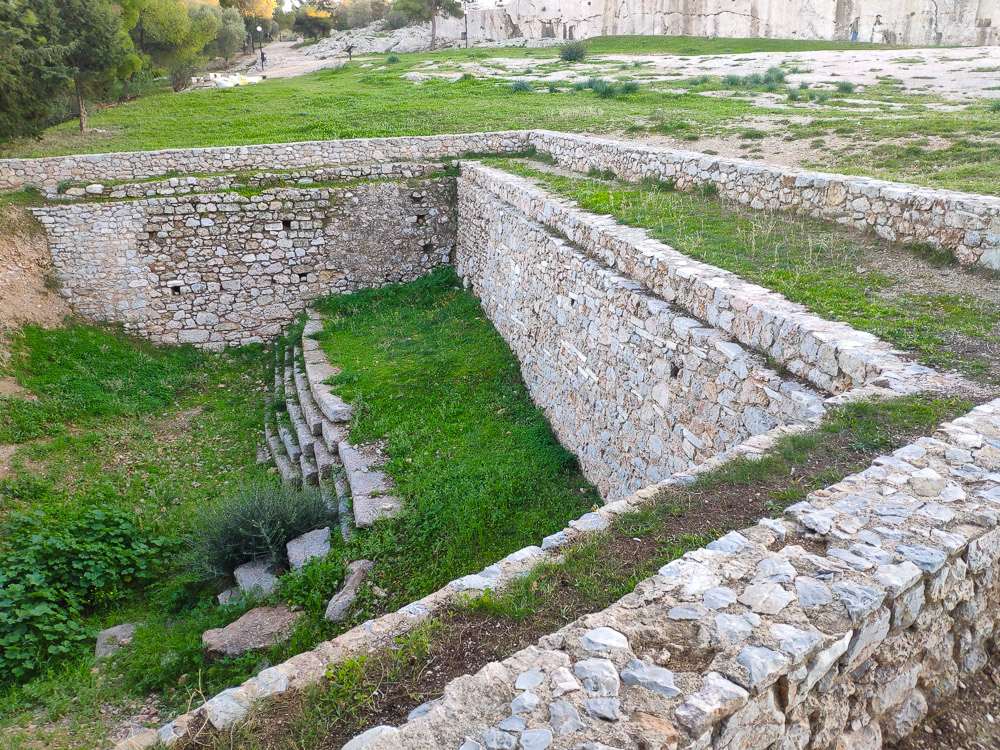

Athenian democracy is considered to have laid the foundations of today’s Western Democracy, but its function in practice would have been very different from our modern day conception of democracy. The Ekklesia’s wide powers covered administrative appointments to the governing institutions of the city, voting on laws and public policies, as well as over more serious matters like the declaration of war. Most of these functions are today usually undertaken by legislative assemblies populated by representatives either appointed or elected, in contrast with the Ekklesia where every adult male citizen was eligible to participate.
For best effect, stand on the site of the Pnyx and imagine that you, a male citizen of Athens who is of age, is about to deliberate and vote on whether to declare war on Sparta. If you’re a political history geek, you can also pat yourself on the back with the knowledge that you are standing in the same place where great orators like Pericles, Aristides, Alcibiades (most notably in respect of the Sicilian Expedition and before he defected to Sparta but that is another story altogether), and Demosthenes once spoke.

Views from the Pnyx
If you’re not interested in the political history of ancient Athens, the Pnyx is nevertheless a good place for views. Standing on the northeastern side of the hill gives visitors a good view of the Acropolis, the Parthenon, and the Lycabettus Hill. The Ancient Agora is also visible slightly to the north, with the restored Stoa of Attalos being particularly prominent.
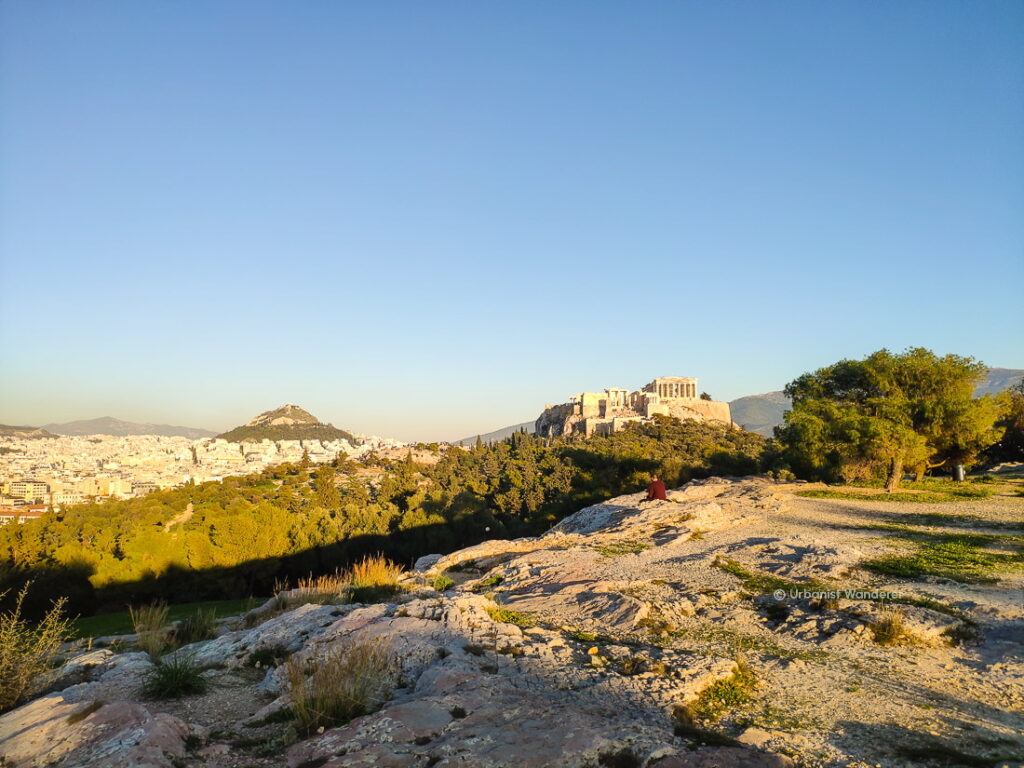
Symbolically, this meant that the Ekklesia met and deliberated in close proximity to both the commercial and religious centres of the ancient city.
Visitor Information
Opening Hours
Both the Philopappos Hill and the Pnyx are opened 24 hours a day and 7 days a week.
Something to note is that I only saw lighting posts at the Pnyx. Walking on the top of a hill with a steep drop to ground level isn’t exactly the safest thing to do at night, so obviously exercise some common sense if visiting at night.
Entrance fee
There are no entrance fees – the entire area is a public park.
Final Thoughts
Both the Philopappos Hill and the Pnyx are easy places to visit for visitors to Athens. Not only is it great for history enthusiasts, the entire parkland is also great for a morning or evening walk regardless.
If you’re visiting the Areopagus, the Acropolis, the Plaka, or just happened to be in the general area, I would recommend spending some time at the Philopappos Hill and the Pnyx.
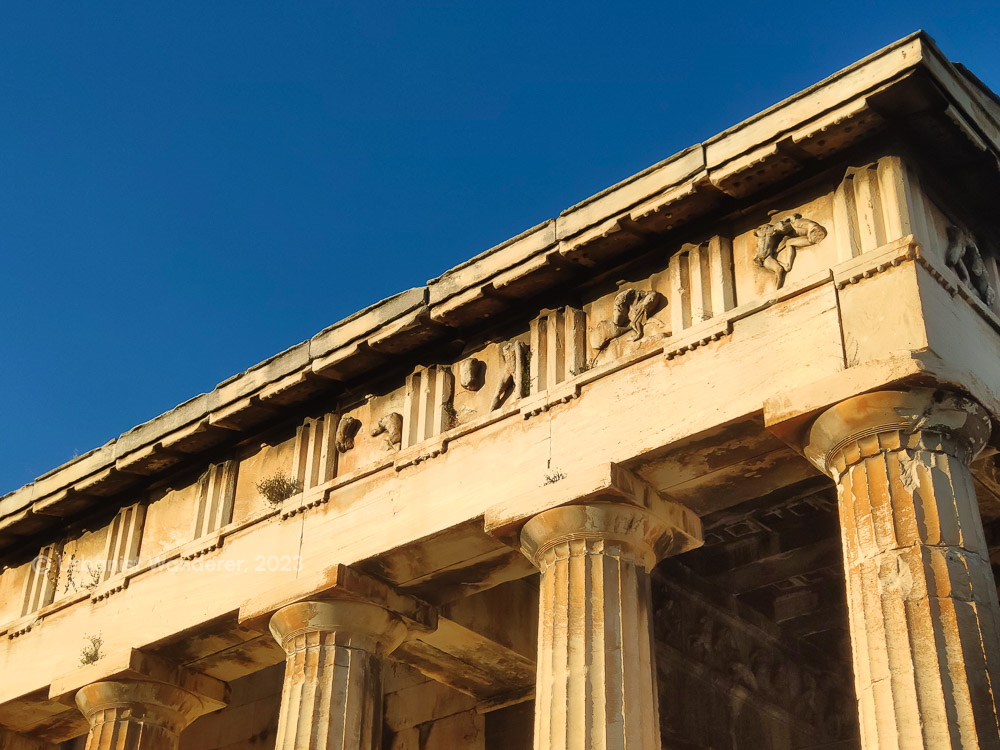

Leave a Reply